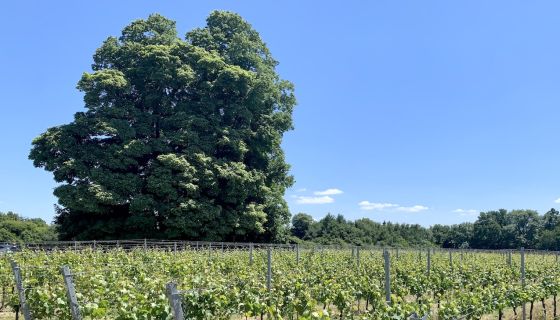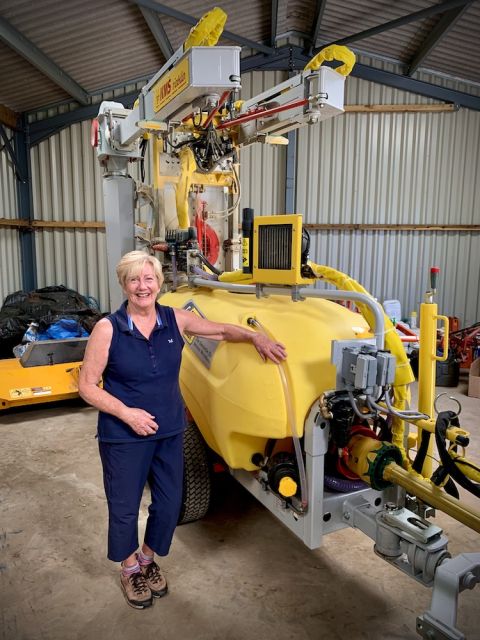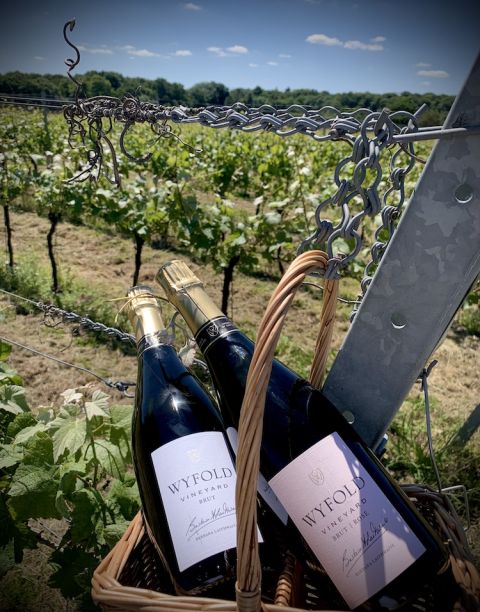Mikey Clark writes Nascent wine writer, casual collector and founder of North West London tasting club ‘Wine Not?’. Studying for the WSET L3 autumn exam.
The Wyfold Vineyard Family Affair
It’s a beautiful, warm June day when I meet the doyenne of English sparkling wine, Barbara Laithwaite at Wyfold vineyard in a quiet fold of Oxfordshire countryside to discuss her ongoing - because it never ends - viticultural regenerative farming methods.
Her methods have transformed land which once lay fallow and are bearing fruit in every sense. Only this year Wyfold’s 2016 Brut won a gold medal at the Wine GB Awards and the 2017 Brut Rosé a gold medal AND a trophy.
I feel honoured that Barbara chooses to meet me at all, as the vineyard is not open to the public and ‘there is no visitor centre, no gift shop or weddings, just our cherished vines growing the most exclusive sparkling wines in England’.
It’s certainly a business model which has a great deal going for it – no people distractions – just the all-important health of the vines to be considered and nurtured. All closely monitored under steely eyes and nimble fingers at each and every stage of the vines’ cyclical lives – winter dormancy, leaf growth, budburst, flowering, fruit set, berry ripening, harvest and back to winter dormancy.
I spy an airborne agricultural well-being barometer; a magnificent, mature red kite soaring high above the massive age-old lime tree (main picture) that dominates the 140m ridge of the perfectly positioned, south facing vineyard slope.
Successfully re-introduced to the Cotswolds in 1990, the red kite, explains Barbara, ‘keeps some smaller birds away but we are susceptible to bird damage in spring and at harvest time. The smaller birds have a taste for emerging buds but I tend to take no action if the damage is minor. I do take precautions as the grapes are ripening pre-harvest because we had our very first harvest in 2005 wiped out by birds.
For ten years or so we netted but I have switched to bird scarers recently. Using bird scarers (the local population is given plenty of notice) takes place over a short period, maximum two weeks and is efficient and harmless to local wildlife’.
Deer are the biggest threat. ‘The whole vineyard is deer fenced. Insects too are a major concern including the imported Australian Light Brown Apple Moth and a relatively new pest, the Japanese Spotted Winged Drosophila. Traps are put out in June and we monitor the population. We rarely have to spray against insects and are very careful as we have beehives nearby’.
Further evidence then, this once unfertile field is flourishing – no self-respecting beekeeper would set up hives in a contaminated landscape.
Though it may be rare to spray, Barbara’s eyes light up when she mentions her new acquisition – a KMS Rinklin ‘over the row’ sprayer. ‘It has two arms so it does two rows at once. It sprays from both sides of the row, delivering the fine spray intensively and efficiently. The previous one was a Hardi octopus sprayer blowing the spray from the centre of a row with quite a lot of wastage. And the Rinklin does two rows for every one the Hardi did which alone halves the effect of the tractor compacting the ground’.
Despite the relatively high, arguably marginal elevation, the vineyard is blessed with a micro-climate and is encircled by ancient woodland. According to Simon Field MW, ‘Being virtually surrounded by trees fosters a particular environment which engenders not only marginally higher temperatures but also the de facto virtues of a complex eco-system’. This may also may also help protect the vines from winter and spring frosts. If, however, a severe frost is forecast, Barbara employs a new eco-friendly polymer spray which provides natural anti-freeze and is non-toxic to plants, humans and animals.
There’s a refreshing, light breeze today and I wonder if there’s a slightly moderating effect from the Caversham Lakes near Henley-on-Thames at over 100 metres lower altitude than the vineyard. This large body of water with its various tributaries is at the end of a shallow broad estuary valley at the top of which, to the northern end of the narrowing valley, lies Wyfold Vineyard.
‘Our soil contains much gravel washed down by the ice age and lots of flints which is very damaging to the machinery but the vines love it!’ Those round flint stones lying on the vineyard surface appear to be doing very good impersonations of mini Chateauneuf-du-Pape galets roulés. Certainly the aspect of the slope is perfectly aligned for the sun’s rays to sufficiently heat them up during the day, reflecting warmth under the vine’s canopy and in the evening radiating heat into the ground, warming the vines and their roots.
And what of the ground – are there any plans to go beyond regenerative farming and move towards organic or biodynamic? ‘My son, and my winemaker, Henry Laithwaite of Harrow & Hope, runs an organic vineyard at Marlow so I can observe how it’s done at close quarters. It’s hard and expensive with lower yields and the vines take time to adjust, never mind the people. When I have discussed going organic myself I have to keep in mind that it’s a long process taking many years. I have 12 years left on my lease, so limited time.
My policy is to improve the soil and follow regenerative farming as much as I can. I concentrate on below-the-ground health as much as, if not more, than above the ground. I make my own compost with turkey and horse manure from local farms, vine shreddings etc. I plant wildflowers and green swards/cover crops between the rows, so there’s no tilling. I aim to leave these two hectares in a much healthier state than they were when I took over’.
Barbara started growing vines here from 2003, adding more in 2014 and Wyfold has remained ‘single estate’ since its inception. No chardonnay, pinot noir or meunier grapes have been bought in from other vineyards, with one notable exception - a pre-phylloxera Bollinger pinot noir cutting given to Barbara by Hugh Johnson who received it from the late Christian Bizot, Head of Bollinger. ‘The vines are still in production today and are included in the Wyfold pinot noir harvest’. How much more regenerative can you get?!
Managing her vineyards assiduously requires extremely hard work and long hours tending the vines, freezing cold pruning in the winter and intense, skilled canopy management in the growing season. All this is achieved with no mains electricity supply to the vineyard, so there’s no convenient jet washing of the viticultural equipment as a small generator is required for even this most rudimentary of tasks.
It’s been a life affirming, educational encounter. Post visit, I open a bottle of the 2017 Brut Rosé and can attest to its excellence – elegant, bright, rosy-cheeked, balanced and delightfully bubbly much like its vigneronne. The Laithwaite contribution to regenerative viticulture is clearly a winner on every level. Long may it continue.
All photographs are supplied by and credited to Mikey Clark.

















